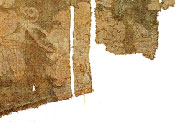 |
 |
|||||||||||||||||||||||||||||||||||||||||
 |
||||||||||||||||||||||||||||||||||||||||||
 |
||||||||||||||||||||||||||||||||||||||||||
| CHAPTER 1 | ||||||||||||||||||||||||||||||||||||||||||
 |
||||||||||||||||||||||||||||||||||||||||||
| 01.01 S-pattern imprinted jade ge dagger 01.01 (c. 16th-11th century BC) |
||||||||||||||||||||||||||||||||||||||||||
| 3/1 on 1/1 weave, or 1-2 pattern on 1/1 ground Dimension: 22.2x4.7cm Palace Museum, Beijing |
||||||||||||||||||||||||||||||||||||||||||
| THE BOOK | ||||||||||||||||||||||||||||||||||||||||||
| AUTHOR | ||||||||||||||||||||||||||||||||||||||||||
| CONTENTS | ||||||||||||||||||||||||||||||||||||||||||
| Imprints of woven silk textiles are found on bronze artefacts. However, very few imprints show a woven pattern. The most well known example is the impression of a piece of qi with lozenge pattern on a bronze yue axe collected in the Museum of Far Eastern Asian Art in Stockholm, Sweden. Another example is the present one, an ectomorph on a Shang dynasty jade ge dagger collected in the Palace Museum, Beijing. It bears the imprint of a tabby weave textile with a S-pattern and cinnabar dyeing. This S-pattern and the lozenge pattern on the Stockholm bronze are both geometric patterns formed by warp floats on a tabby ground, with the floats crossing over three threads in each case. According to the author's research, this could have been produced by a unique 1-2 weaving technique, which results in patterns of equal width, and in each unit of the pattern being always parallel or perpendicular to one another. This feature is observed in all woven patterns of the Shang dynasty. Presently only a portion of the textile is seen. On speculation, the rest of the fabric may consist of a straight repeat of this S-pattern. Another possibility is that the S-pattern is part of a larger geometric design. Note: Chen 1979; Zhao 1995 |
||||||||||||||||||||||||||||||||||||||||||
| ORDER | ||||||||||||||||||||||||||||||||||||||||||
| CONTACT | ||||||||||||||||||||||||||||||||||||||||||
| LINKS | ||||||||||||||||||||||||||||||||||||||||||
|
|
|||||||||||||||||||||||||||||||||||||||||